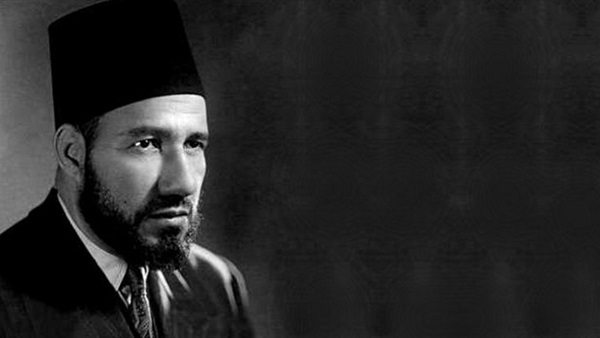Al-BANNA, FROM ADVOCATING ISLAMIC ATTIRE TO ALLIANCE WITH A BULLY

Leaders of the Muslim Brotherhood
(MB) surround the memory of Hassan al-Banna with the aura of a prophet.
Al-Banna was the man who, in 1928, founded the MB organization that developed,
over the years, into a world network of terrorist franchise groups. This man,
often described by his followers as the leader of an Islamic Risorgimento, was,
according to those who knew him well, a man whose deeds belied his words. It is
curious how his followers, even now, after almost seven decades of his death,
never think of what he said and then went back on, only because his own
interests dictated a change of mind.
In his book 'Memoirs of the Call
and the Caller', al-Banna stated that he was committed to wearing an Islamic
dress, which he described as being similar to the dress of Ihram, or the attire
of a Muslim pilgrim. He said that in the course of a rather rough give-and-take
that went on, between him and the Director of Education, in Damanhour (Behaira
province, Egypt), when he walked into school donning a white imama (turban)
with a dangling tail, a white cloak over his jilbab (garment) and a pair of
sandals that left his feet half- covered, he looked so much like Sufis because
he himself had once been a member of the Hassafi Sufist order.
This happened when he was hardly
sixteen years old, in a school training young men to be teachers of Primary
Education, al-Banna tells us, in his Memoirs. The Director of Education, Hassan
Ragheb, insisted on the need for Hassan al-Banna, like all other students, to
go by the school dress code. He asked the young al-Banna' :'Why are you dressed
up like this?' Hassan al-Banna replied: 'This is Sunna.' The Director asked:
'And have you done everything the Sunna tells you to do, before coming to this?
Al-Banna said 'No. We are all to blame for not being committed enough to Sunna,
but, at least I'm trying.' Ragheb said:' You are breaking the school-rules with
this kind of dress.' Al-Banna asked: 'why, sir?'
A noisy argument erupted, as
al-Banna insisted on his traditional garb, claiming that this was not a
violation of any rules. Ragheb gave him this piece of advice:' If you insist on
this garb, even after you finish this school, the provincial Education Council
will not give you a teaching job, because you will look strange, to your own students.'
In a challenging tone, al-Banna said that only God provides and that it was too
early to think of getting a job. When the time comes, he said, the Directorate
would be free to accept or refuse the way he chose to dress up.
A change of
attire by the Quranic Man
After joining Dar al –Uloom Academy
in Cairo, the Quranic Man, as Hassan al-Banna was described by American
Journalist Robert Jackson, changed attire. He committed the 'sin' of wearing a
suit and a tarbush (fez), after having, for several years, condemned others for
doing just that. He gave up the imama and jilbab that had been, a few years
before, the reason behind the dispute with the Director of Education. He would
be seen, in this dress, in Egypt and abroad, for many years to follow.
The 'Imam' and
the bully
Another episode in the life of
Hassan al-Banna, according to ikhanwiki, the online encyclopedia recording
events of MB history, features a man named Ibrahim Kroom, referred to by MB
members as the 'repentant thief who became attached to al-Banna'. This man is
said to have given up terrorizing and extorting people, only to become a member
of the group, serving the faith and the community.
Kroom, who had been known to people
in the Cairo districts of Boulack and Sabtiyya (Cairo North) as
Fetowwa (bully) who imposed levies on them, joined the Brotherhood, at a
certain point of his life and became a friend of al –Banna. His Son, Mostafa
Kroom said in a videotaped interview, broadcast in 2015, that his father' Never
went without his nabbout (cudgel), the instrument that helped him garner money
from the well-off, in his neighborhood and beyond. He gained the title Fetowwa
in 1926, when he managed to kill with his nabbout a number of people that tried
to stand up to him. In ikhwanwiki, Kroom features as a completely different
person, as a businessman dealing in scrap metal and owning a coffee-house who
used both his house and his coffee-house as places where he solved people's
problems. This made his house and his coffee-house a Justice Diwan.
According to a testimony by the
founder of the MB secret intelligence group, Mahmoud Assaf, Kroom won the
admiration of al-Banna when the latter saw how Kroom managed to force
shop-keepers to make donations to al-Banna's organization. Al-Banna greatly admired
Kroom and used to receive him in his private house. In his book, 'With Imam
Shaheed, Hassan Al-Banna', Assaf says that Kroom was as strongly
attached to Imam and to the Brotherhood as Imam himself was attached to him.'
So, the Quranic Man had no qualms about extorting people, as long as the money
resulting from this extortion found its way to the coffers of his organization.





